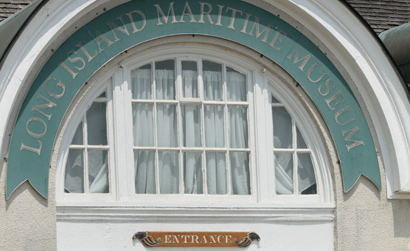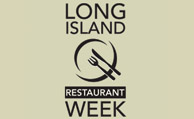
By Matthew Manguso
The Priscilla bobs freely in the waters of the Great South Bay until, with a strong, stern voice, Captain Mike Caldwell cries, “Haul away!” The crew raises the sails, and as the canvas fills with wind, the Priscilla reclaims her waters. The passengers look out over a solitary bay. As the 19th century oyster sloop comes about, she points her bow toward West Sayville and the Long Island Maritime Museum, a tiny not-for-profit telling the story of Long Island’s fellowship with the sea.
At the helm of the Maritime Museum—which is on celebrating its 19th Annual Seafood, Craft and Music Festival on Aug. 28 and 29—is Executive Director Natasha Alexenko. Alexenko is Long Island’s prodigal daughter; born in West Islip, she has lived throughout North America. Like most of the staff, she began as a volunteer. In April 2009, she was appointed executive director. Behind her amicable disposition is a knowledge of maritime culture deep as the ocean. “The mission of the museum is to educate people on a part of our history,” she says, in her office, where the floorboards creak like a ship and salt air wisps in through open windows. Says Alexenko, for Long Island, that history is “linked with the sea.”
If the Maritime Museum is a ship then Alexenko is the captain. “The museum is a unique place filled with unique people,” says Caldwell. “Our director has a lot of foresight and a sense of vision.” Alexenko may have allowed the museum to thrive, but like any ship, it is the collective effort of the crew that keeps it afloat.
Testing the slackness of the rigging and reminding the crew to attend to the jib and boom, Caldwell sits aboard the Priscilla, detailing her uniqueness. “We’re very fortunate to have Priscilla. Her design is incredible, even today…she is truly a 19th century boat.” But more than that, Caldwell explains, “The Priscilla is a reminder that we come from a past that relied on the ocean for our survival.”
It took 19 months to restore Priscilla to her 1888 self in the hopes of making her an active exhibit—one which is alive and put to use. In 2006, Priscilla was designated a National Historic Landmark by Congress. In May 2010, she had her maiden voyage in all her beauty. Now, for only $25, visitors to the museum are able to experience a sailboat in the Great South Bay. “This is what Long Island is all about,” declares one passenger.
A similar experience is achieved on land at The Frank F. Penney Boat Shop, where boat building and restoration takes place. Inside, volunteers sand, plane and spin yarns like our ancestors did a hundred years ago. They eagerly wave visitors over, proud to show off their hard work.

Without volunteers the museum would be adrift. “The volunteers are very mission oriented. When you’re enthusiastic about something, and you go out into the world and talk about it, it’s contagious,” says Alexenko.There are dozens of volunteers, but more hands are always needed, especially young hands. “People aren’t going to volunteer when they’re working two jobs just to pay the bills,” says Tom Holmes, a volunteer who works the museum door. But the Maritime Museum is a special place, and more often than not you find paid staff members volunteering their free time and skills, like David Swanson of Amityville Harbor, who works with the museum’s computers and volunteers aboard the Priscilla. These actions are a testament to the spirit of the museum, but restoration, upkeep and maintenance cannot happen without money.A volunteer motions toward old, deteriorating boats. “We have plenty of projects, but no money to start them.” The museum relies on grants, donation and fundraisers, so on Aug. 28 and 29 they will offer something to Long Island that is sure to attract schools of people: seafood.
“It’s become very much a part of the Long Island culture,” says Alexenko. “We celebrate seafood, which is such a part of our history.” In addition to delicious food, visitors can purchase folk art from local artists and listen to live music, and of course the museum and all its exhibits are open to the public, as are rides aboard the Priscilla, all for a $5 admission fee.
Making its second appearance at the festival is Vincent’s Clam House of Carle Place, a restaurant that, like the museum, is a purveyor of Long Island tradition. “We use everything homemade and use as much local as we can. All our clams come from the North Shore, our lobsters are Long Island lobsters,” says owner Bobby Marisi.
The festival is something everyone can indulge in. Adults have the seafood and children can participate in nature walks, knot tying contests and come face-to-face with some classic maritime characters. Inside the Museum are treasures from LI’s past, but what makes it unique is it shows those treasures are still present. As the Priscilla returns to port, a gust of air catches her sail. Some of the passengers reach for their seats, but Caldwell stands smiling, “Priscilla is a smart boat. She does what a good boat should.”
The Long Island Maritime Museum is located on the West Sayville waterfront. For more information, call 631-HISTORY or go to www.limaritime.org.








